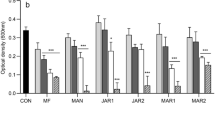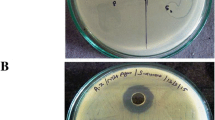Abstract
The purpose of this study was to investigate the effects of manuka honey on the structural integrity of Pseudomonas aeruginosa ATCC 27853. The minimum inhibitory concentration (MIC) and the minimum bactericidal concentration (MBC) of manuka honey for P. aeruginosa were determined by a microtitre plate method, and the survival of bacteria exposed to a bactericidal concentration of manuka honey was monitored. The effect of manuka honey on the structure of the bacteria was investigated using scanning and transmission electron microscopy (SEM and TEM, respectively). The MIC and MBC values of manuka honey against P. aeruginosa were 9.5% (w/v) and 12% (w/v) respectively; a time–kill curve demonstrated a bactericidal rather than a bacteriostatic effect, with a 5 log reduction estimated within 257 min. Using SEM, loss of structural integrity and marked changes in cell shape and surface were observed in honey-treated cultures. With TEM, these changes were confirmed, and evidence of extensive cell disruption and lysis was found. Manuka honey does not induce the same structural changes in P. aeruginosa as those observed in staphylococci. Our results indicate that manuka honey has the potential to be an effective inhibitor of P. aeruginosa.



Similar content being viewed by others
References
Branski LK, Al-Mousawi A, Rivero H, Jeschke MG, Sanford AP, Herndon DN (2009) Emerging infections in burns. Surg Infect 10(5):389–397
Keen EF 3rd, Robinson BJ, Hospenthal DR, Aldous WK, Wolf SE, Chung KK, Murray CK (2010) Prevalence of multidrug-resistant organisms recovered at a military burn center. Burns 36(6):819–825
Fazli M, Bjarnsholt T, Kirketerp-Møller K, Jørgensen B, Andersen AS, Krogfelt KA, Givskov M, Tolker-Nielsen T (2009) Nonrandom distribution of Pseudomonas aeruginosa and Staphylococcus aureus in chronic wounds. J Clin Microbiol 47(12):4084–4089
Blair SE, Carter DA (2005) The potential for honey in the management of wound and infection. J Australian Infection Control 10:24–31
Molan PC (1992) The antibacterial activity of honey. 1. The nature of the antibacterial activity. Bee World 73:5–28
Cooper RA, Halas E, Molan PC (2002) The efficacy of honey in inhibiting strains of Pseudomonas aeruginosa from infected burns. J Burn Care Rehabil 23:366–370
Cooper RA, Molan PC, Harding KG (2002) The sensitivity to honey of Gram-positive cocci of clinical significance isolated from wounds. J Appl Microbiol 93:857–863
French VM, Cooper RA, Molan PC (2005) The antibacterial activity of honey against coagulase-negative staphylococci. J Antimicrob Chemother 56:228–231
Wahdan HAL (1998) Causes of the antimicrobial activity of honey. Infection 26:26–31
Willix DJ, Molan PC, Harfoot CG (1992) A comparison of the sensitivity of wound-infecting species of bacteria to the antibacterial activity of manuka honey and other honey. J Appl Bacteriol 73:388–394
Karayil S, Deshpande SD, Koppikar GV (1998) Effect of honey on multidrug resistant organisms and its synergistic action with three common antibiotics. J Postgrad Med 44:93–96
Kwakman PH, te Velde AA, de Boer L, Speijer D, Vandenbroucke-Grauls CM, Zaat SA (2010) How honeys kills bacteria. FASEB J 24(7):2576–2582
Blair SE, Cokcetin NN, Harry EJ, Carter DA (2009) The unusual antibacterial activity of medical-grade Leptospermum honey: antibacterial spectrum, resistance and transcriptome analysis. Eur J Clin Microbiol Infect Dis 28(10):1199–1208
Henriques AF, Jenkins RE, Burton NF, Cooper RA (2009) The intracellular effects of manuka honey on Staphylococcus aureus. Eur J Clin Microbiol Infect Dis 29:45–50. doi:10.1007/s10096-009-0817-2
Allen KL, Molan PC, Reid GM (1991) A survey of the antibacterial activity of some New Zealand honeys. J Pharm Pharmacol 43(12):817–882
Lemar KM, Turner MP, Lloyd D (2002) Garlic (Allium sativum) as an anti-Candida agent: a comparison of the efficacy of fresh garlic and freeze-dried extracts. J Appl Microbiol 93:398–405
Acknowledgements
We wish to thank Drs. Hann and Turner of the Electron Microscope Unit at Cardiff University, Wales, UK.
Author information
Authors and Affiliations
Corresponding author
Rights and permissions
About this article
Cite this article
Henriques, A.F., Jenkins, R.E., Burton, N.F. et al. The effect of manuka honey on the structure of Pseudomonas aeruginosa . Eur J Clin Microbiol Infect Dis 30, 167–171 (2011). https://doi.org/10.1007/s10096-010-1065-1
Received:
Accepted:
Published:
Issue Date:
DOI: https://doi.org/10.1007/s10096-010-1065-1




